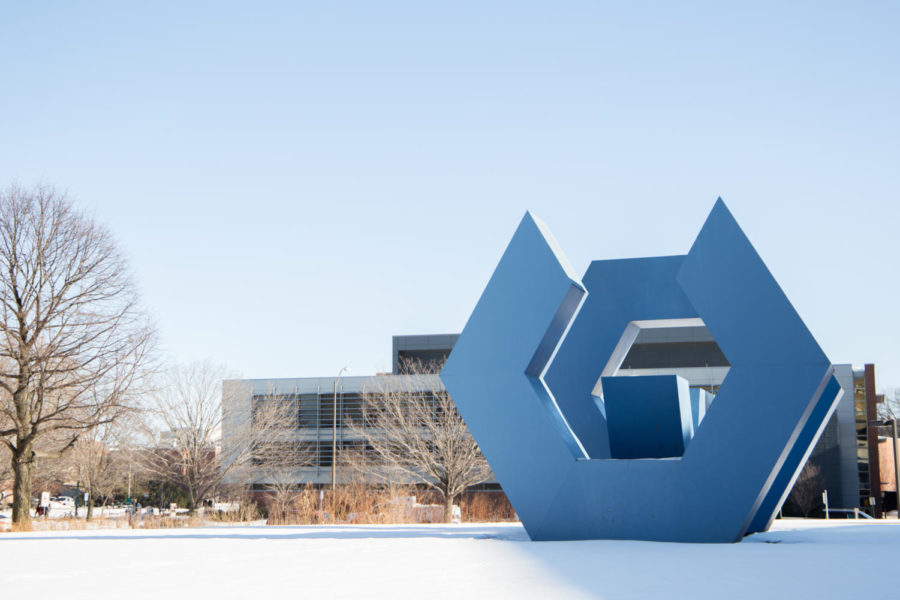College of Design’s pitch off winner and runner up
Mikinna Kerns/Iowa State Daily
The painted steel sculpture, entitled Sequence, rises from the snow Jan. 8 outside the College of Design. The sculpture was erected in 1979 by John Douglas Jennings and has become a landmark for the College of Design.
February 22, 2018
Anxiousness and letting jittery nerves get the best of his confidence was how Steven Abramsky, junior in industrial design, was feeling right before his presentation at Iowa State’s College by College Pitch Off.
Abramsky along with his teammates: Noah Goedken, sophomore in pre-business; Ty Cook, sophomore in supply chain management; Ben Slevinski, sophomore in forestry; Trace Harken, sophomore in mechanical engineering; Quinton Houg, junior in mechanical engineering; and Sadie Lewman, senior in industrial design, competed in the 90 second pitch contest, representing the College of Design.
There were approximately ten other contestants for the College of Design, including runner up Kaylinn Taggart, fifth year architect student, and Emma Martin, senior in interior design.
“I received the email about the contest and my friends brought it up too,” Abramsky said. “I just wasn’t sure if I wanted to put out idea out there so I kind of sat on it for a little bit. Then I met with my good friend and we decided we should just do it.”
For Taggart and Martin, their decision came a little more unexpected.
“We found out about it the day before the competition,” Taggart said. “It was a very last minute thing.”
Martin wasn’t aware Taggart ended up signing up and competing, until Taggart told Martin their results after the fact. But Martin was “so proud of [Taggart]” for pursuing their idea.
The initial ideas for both teams generated from class projects.
“When I was a sophomore in industrial design I had a project,” Abramsky said. “It was to think of an everyday product and design it as if it would be produced in the future.”
Abramsky’s team pitched a new razor for women. According to Abramsky, it is a 360 degree architecture that will be primarily for women.
The market for razors does not currently have a whole lot of innovation occurring, according to Abramsky. Which means it’s monumental for its market space, allowing the potential product to stand out. When he initially thought of this product for the class project, Abramsky knew he needed to abstractly design this everyday product.
“It just came to me all of a sudden,” Abramsky said. “A scene from an old childhood movie triggered the initial idea. It was so crazy.”
Over the years, Abramsky always had this project in the back of his mind. He really liked the idea and concept of his razor for women.
“I think it could really change things for shaving,” Abramsky said. “There’s a big social aspect to shaving. We feel as though shaving should be something that is empowering for women.”
Taggart and Martin decided to collaborate during a class to develop their idea.
At the contest, Taggart pitched a mobile device with drone technology for rural areas to make access for prenatal and maternal care more efficient.
“This would help teach people how to be healthy and make people not afraid to go to the doctors,” Taggart said.
According to Taggart, traveling to seek health care takes a long time in some rural areas. This device would be mobile, in order to bring health care and a clinic to the people.
“Drone technology fits into this idea because the medicine would be delivered by drone,” Martin said.
According to Taggart and Martin, the hardest part about the project would be figuring out how pieces actually come together to function.
For Abramsky, there were a lot of hard aspects.
“The marketing aspect is going to be tough because we are changing a behavior with what we’ve done,” Abramsky said.
Changing the razor is something that will have to be taught and accepted. Engineering and the business aspect is going to be tough for the team, according to Abramsky.
Both teams have aspirations for the future of their products.
“We want to keep working on it,” Taggart said. “And if it goes well, we want to patent it and try to implement it in real life.”
Abramsky wants to get proof of concept to start working on mass produce and working prototypes.
Taggart and Martin, as well as Abramsky’s team are competing in the final round of the pitch off contest on March 6.







